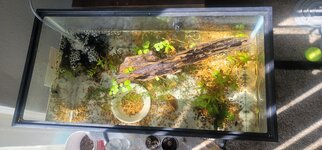That's good to source the water from the pond. Make sure you are changing the water daily though. Especially with this mystery thing. With plastic containers you HAVE to do 50% water changes daily. Have a filter (sponge filter if you can) for the big tank. With this condition, I might switch to declorinated water for the time being in the containers to make sure that it is not something in the water. You can still feed them mosquito larvae and such from the pond though. My pond I found mine in has a small section that Is very stagnant and I believe will kill things. It is muddy and red colored slime. I have found multiple dead frogs in only that one section. That's why I say switch to treated tap water until you know for certain, just a few days.
For the record, I am doing the same thing as you, raising and releasing newts. But my newts are in the eastern USA. So mine are quite different. Mine are toxic to other larvea and fish so I have not had anything other than food in my tank. Also, if your tank is over crowded (even as larvea) that could cause problems too. The tank I have is probably the same. I have 6 large newt larvea in it. I wouldn't keep more than 20 SMALL larvea in it. Even if you had 6 fish, 6 tad poles and 8 newts. You get the jist. But you will need more space. And soon!
Lol I have set up 3 tanks. A total of 80 larvea. 50 of which are only 4 days old though. They are in a tank that is 60cm x 24 cm. That's why they aren't over crowded... yet. But they will be in 3 weeks.


